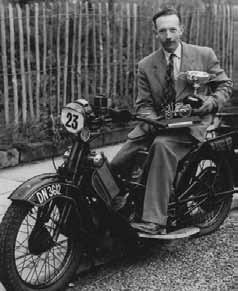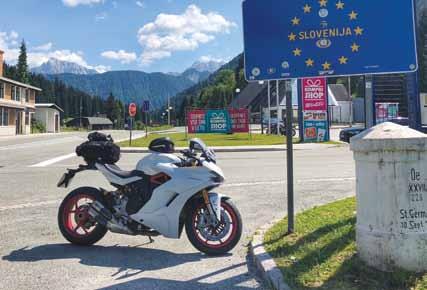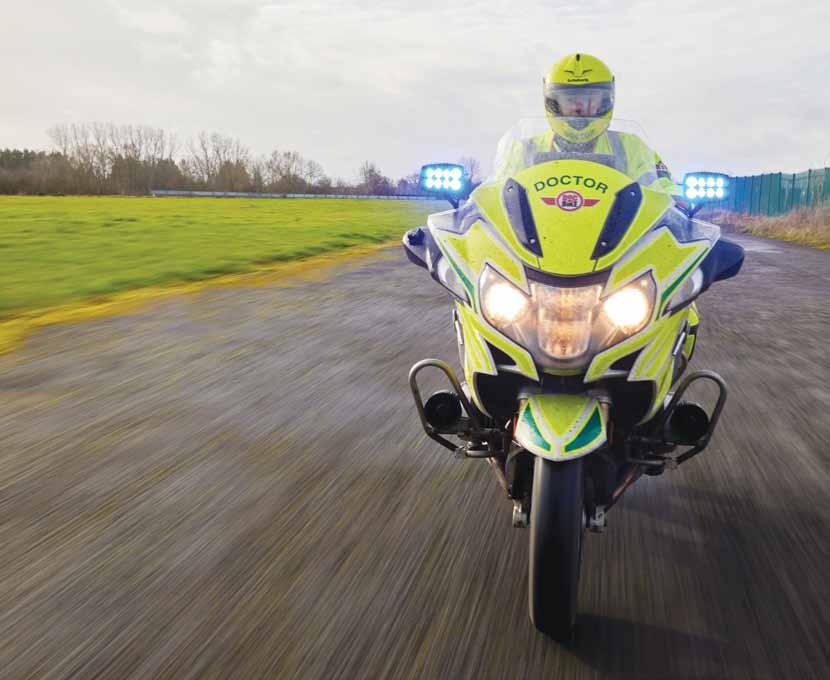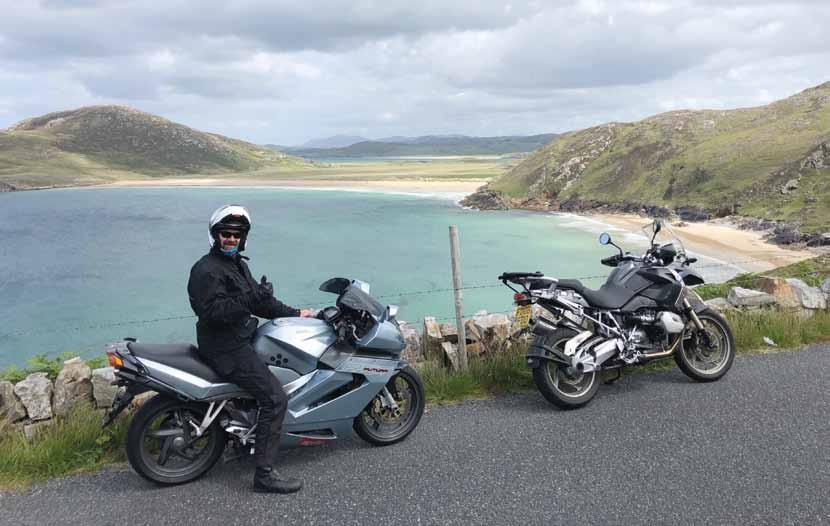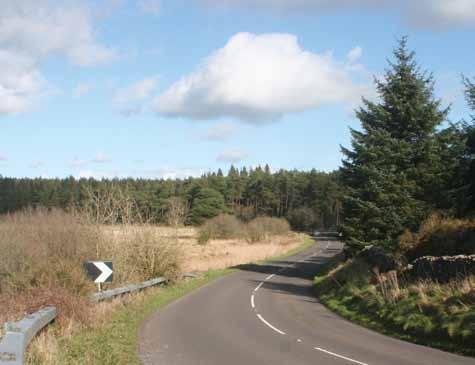
15 minute read
FEATURES
Fire Starter Meet Louise Hillier – new designer of Motorcycle Rider – and read how the White Helmets trained her to jump through fire Words: Louise Hillier Pics: Philip Mingo - @ppauk

Advertisement

What am I doing? I must be completely stupid! Nuts, crazy, insane, not the full ticket and one spanner short of a toolkit. Fifty metres back, I can feel the heat of the flames. I remember seeing riders jump through ‘fire’ as a kid - delicate little arches that smoked gently. What I’m faced with here looks more like an almost solid wall of flame and heat. The ramp I have to aim for looks about as wide as the knobbly tyres on the Honda XR250 I’m sitting on. I rode this bike for the first time a couple of days ago and jumped off a ramp yesterday – again, that was the first time. But there’s no going back now. Into gear, accelerate towards ramp, into second, third...and I’m flying.
I had joined Motorcycle Sport & Leisure magazine as a designer, but got roped into editorial as well, embarking on a series of biking challenges. ‘Challenge Lou’ had had me riding everything from a KTM enduro bike to a vintage Henley, but there was one thing I hadn’t done – stunt riding. And it looked as if I’d got away with it until some smart alec reader wrote in and asked why I hadn’t spent a day with the Royal Signals White Helmets. Well that was fine, I could live with that. Until Lt-Colonel Amberton of the Royal Signals wrote in after he’d read that: “come and spend a week with us,” was the gist of it.
For all the Colonel’s reassurances (and he was a very nice man) that I wouldn’t be pushed into doing anything I wasn’t ready for, the colour had already drained from my face. I’d been there, I’d seen the White Helmets’ ‘Pyramid’ and high-speed criss-cross riding, and to me it seemed a challenge too far. Still, I would be part of a group of novices, some of whom had never so much as sat on a bike before. They all had an induction week which basically taught them how to ride, and I came on board for the second week, which teaches those arena skills that the seasoned riders make look so easy.
Private Benjamin
So off up the A303 on my Honda Dominator to Blandford, a quaint Georgian town in north Dorset and the Royal Signals’ base. This is the army, so the first priority was to get me in uniform. Green (not white for a novice) open-face helmet, Alt-Berg boots, green fleece, green jacket and green combat trousers. Oh, and a bib with ‘37’ written on it. I looked like something out of Private Benjamin. Why an open-face helmet, when we’re doing dangerous stunts? “Oh, that’s so the audience can see your face - it makes the show more personal.” Right.
I didn’t feel quite as out of place when we reached the rest of the group – they were all dressed the same as me. All ten were army regulars who had applied to join the White Helmets, and for them, this was a make or break fortnight. Already, one woman had been airlifted out the previous week with a dislocated shoulder. This week, she was back again, only to break her wrist – I heard she was determined to come back and have another go...
Anyway, the first challenge was to ride the standard White Helmets bike, a Triumph Tiger 750. This was the old Meriden Tiger, not Hinckley’s adventure tourer, and was already out of
Top left: white Helmets were a team Top right: Triumph Tiger 750s were still the bike of choice Below: Louise (right) benefited from good instructors




date when they ceased production in the 1980s. Why, after all this time, do the White Helmets carry on using them? Light weight, good torque and strength are said to be the main reasons. The Triumphs are solid bits of kit (I was already slipping into Army terminology), easy to modify and maintain. And they’re British! The only flaw in this plan came when the teams needed new bikes a few years ago: Meriden was long gone, and even Les Harris (who built Meriden Triumphs under licence in the late 1980s) didn’t have a licence to make them any more. But he could make spares. A lorry load of Triumph bits was duly shipped up to Blandford, and the Royal Signals built up 30 bikes themselves. Apparently Hinckley wasn’t best pleased that someone else was making ‘new’ Triumphs, however specialised.
Kick starting these old Triumphs was an art in itself, and I couldn’t master it. So like Penelope Pitstop, every time I stalled someone had to run over to kick the bike back into life for me. Anyway, the Tiger was surprisingly pleasant to ride – nice and tractable, with a low centre of gravity – and after a couple of hours doing figure of eights and slalom, my instructor Adam told me to follow him and do as he did. Riding in a straight line: one hand on your helmet, then one foot on the seat, then both...I couldn’t believe it, I was riding a bike and standing on the seat. By the end of the day, I felt quite chuffed.
Tricks
The next day, things got trickier. Now in with the main group, we all had to take the next step towards real stunt riding. Just as scary was the sound of twelve unsilenced Triumphs making the ground vibrate. We had to ride two abreast and go round in a figure of eight...which doesn’t sound hard. Now make that a handlebar’s width apart, and you have to keep absolutely side by side. The key seems to be to set your speed and use the rear brake (not the throttle) to slow down.
One person to one bike was obviously getting too easy, so we swapped onto one of the trick bikes, basically a Triumph with a rigid rear end and a ‘sticky’ throttle that allowed you to ride hands off. The ‘Swallow’ consisted of me lying along the seat and tank, with the instructor standing up on two foot boards sticking out either side of the seat. He was controlling it, not me! I felt just as I did when I was forced to do algebra at school - why?
Then the ‘Four Tee’: I sat on the handlebars while three guys sat on the bike behind me - I suppose one of the fundamentals of being in the White Helmets is that you trust every other rider implicitly. Finally, the ‘Three Bike Fan’, the basis of the Pyramid. Three of us had to ride abreast, inches apart, while two guys stood in between the bikes. One rider fell off...so we all did. Forget Anne Robinson’s old quiz show – the White Helmets was all about the Weakest Link.
Just when I was thinking it wasn’t all that bad, I was told it was time to jump a ramp. They didn’t use the Triumphs for this (too heavy for novice jumpers), and bog standard Honda XR250s, with no modifications whatsoever, are far more suitable. I was shown the XR. Then I was shown the ramp. Err, have you got a smaller one, I quavered? It came up to my thigh and was about as wide as a builder’s plank. I really didn’t think I could do this.
Above left: Starting the big twin was a leap too far Above middle: Only one of these trainees is smiling… Above right: Joy or fear? You decide….

“Do you want to see me do it first?” said instructor Stan.
Next thing I knew, I was lining up to do it myself. First gear, second gear, aim for the white line and over! Legs locked (which forces the rear wheel down first, so you don’t nosedive) and we were down! Sheer glee. And again, with third gear and more speed. By this time everyone was watching, and as I landed, both hands came off the bars, but I managed to grab hold again and stay on. I was told to stop waving at people.
Next day, after all that, I knew I’d have no choice but to tackle the fire jump. Four riders had made it through the day before, despite a strong wind, and apart from a bit of singed hair no one was hurt. But now the photographer was here, and I felt duty bound to have a go. We lined up; they lit the fire. It’s just like the ramp without fire, I kept telling myself, same technique. Photographer Phil Mingo tells me I was actually grinning as I flew through the flames. Well, either that or a silent scream.
verdict
What an incredible week it was. If nothing else, it proved to me that with trust, belief in yourself and brilliant instruction you can achieve what seems impossible. Thanks to everyone at the White Helmets who made me so welcome – it turned out I was the only civilian female ever to tackle the fire jump. Just as I was about to go, one of the instructors told me I was a chick with balls. Tops. This article first appeared in Motorcycle Sport & Leisure

Who Were the White Helmets?
Who of us didn’t see the White Helmets at one time or another, at open air bike shows, steam fairs and the like? They performed their daring stunts publicly for 60 years, before being sadly disbanded in September 2017, when it was thought that their despatch rider origins didn’t fit with modern high tech Royal Signals.
The Royal Signals Motorcycle Display Team – to give its full official title – had its origins in despatch riding during the First World War, when riders were used to deliver messages between HQ and the front line, and became part of the Corps of Signals in 1920. The Signals riders were young men in their twenties, good riders and keen on bikes, so one thing led to another...they were soon developing their own stunts.
Recognising the good PR coming out of these public displays, the Royal Signals display team was formed in 1927. Its early shows actually featured horse riders as well as motorcycles, but as fewer horses were used by the military, these were dropped to concentrate on the bikes.
Some spectacular stuns were developed, including the fast crossover, juggling while riding backwards, the human pyramid and of course jumping through fire. The team, which had a rolling membership, performed under various names over the years. ‘Mad Signals’ was a reference to the early bikes’ weak brakes and ‘The Red Devils’ was used before the Parachute Regiment nabbed it. They settled on the White Helmets in 1963.
The end came when top brass decided that the White Helmets didn’t fit in with the Royal Signals focus on high tech communications – despatch riders had long since gone the way of the dodo. “The problem is that, when you look at the Royal Signals today, it’s about cutting-edge cyber warfare,” said one senior officer at the time. “The image of chaps performing stunts on motorbikes is fun, but really doesn’t speak to modern-day youth who have grown up in a digital age.”
The White Helmets gave their final performance in September 2017 at their home base of Blandford Forum in Dorset. A sad day, but who knows how many young motorcyclists they encouraged over the years?
RACING INTO 2021

Bradley Wilson – team thorneycroft 56 in Supersport – looks forward to a new season
Ididn’t start out riding bikes from a very young age, and a career in racing wasn’t even a consideration. Until I took my CBT in February 2016 I had never even touched a motorbike, never mind ridden one. But as soon as I started riding, I was hooked.
The racing story began when my aunt married Hudson Kennaugh, who was 2013 British Superstock 1000 Champion and provided my gateway into motorcycle racing by helping out his team. It wasn’t a glamorous start, and initially I was the team brew maker but I asked Hudson if I could have a ride. He gave me a try and the rest, as they say, is history.
In 2019 I raced with the Microlise Cresswell team in the Standard class Moto3. It was a mixed season, but I also finished third in the Southern 100 race on my first time out.
I managed to break my leg during one of the BSB races at Thruxton, and while this did scupper my season, it also meant that I was at the right place at the right time at Oulton Park, spending a lot of time chatting to the Thorneycroft’s team. Shortly afterwards they offered to sponsor me, which enabled me to set up my own team, Thorneycroft 56 racing.
I was lucky that Mervyn Richmond decided to join the team as co-owner. We’ve been friends for a long time and I really couldn’t race without him – certainly couldn’t imagine anyone else on the spanners! I also teamed up with my mentor/ manager Richard Mortimer again during the 2020 season.
I started 2020 with a style of bike I’ve never ridden before – the 400cc Kawasaki. My main target was to finish in the middle of the pack at BSB, have some good battles, learn and adapt as much as possible. Obviously Covid meant that the season was delayed but I did manage to get some racing in. I learnt a lot about running a team, riding in Supersport, and by the end of the season I had realized that a lot of it comes from your own attitude and belief. It was also clear that I have a really good team around me, not least my fellow rider Connor Sellors.
Above: Learning curve – Bradley is concentrating on honing his riding technique Left: Thorneycroft’s sponsorship enabled to Bradley to set up his own team
Looking to 2021
I am ready to race again this year, with an improved perspective of what I need to do. I need to mess about with the bike less and concentrate on improving the way I ride it. This season the team colours will be represented by Connor and myself, joined by Harrison Dessoy, which is really exciting.
The Supersport class at BSB is so important to encourage young riders and spectators. Connor and Harrison are both young lads with a passion for bikes and motor sport. It’s really important that young people are given the opportunity to take part in the sport and to be around bikes with the best training and guidance. After all we are the future of motorbikes. Mind you, the costs involved in racing can be prohibitive and we do rely on sponsors so are always on the look out for businesses and individuals who are as passionate about bikes as we are.
I am really excited about the 2021 season and hope that the crowds will be back as soon as they can. Look out for our distinctive Thorneycroft Pink bikes on the track and check out my facebook page Thorneycroft 56 racing to follow my progress.

GET THE APP!
You’ve just been knocked off your bike – what happens next? Thorneycroft’s Motorcycle Assist app could help. Thorneycroft Solicitors are keen supporters of motorcycle safety and we actively support a number of organisations such as Upright Derbyshire and Biker Down. We supply medical data carriers free of charge – these contain all of your medical and contact data for the emergency services in the event that you are unconscious. We have also developed an app which riders can download for free and use following an accident – Motorcycle Assist. We understand that if you are involved in a collision you may be quite shaken, and may not remember what you need to do. Motorcycle Assist guides you through the steps you need to take in the event that you do have a collision with a third party.
The app guides you through the important initial evidence gathering steps and gives you a platform to record the accident details, defendants’ details, accident location, witness information, photographs etc. This information will then be sent directly through to us so that we can take the necessary steps quickly and efficiently.
Motorcycle accidents require special consideration, and you should use a specialist bike solicitor if you have a collision. Remember that you are not obliged to use the solicitors your insurer tells you to use, as they may not be specialist motorcycle solicitors. You are well within your rights to pick the solicitors you want to use. As BMF members you are also assured of a discount in respect of any success fee if you use Thorneycroft.
the Crash List
• What do to in the event of an accident: Make sure you are safe • Do you need the emergency services? • Are there any other casualties? • Collate the information required – Motorcycle Assist will guide you through this, but in essence you need: • The other party’s name, address and phone number • The other party’s vehicle registration • Witness details • Location of the accident • Attending police details • Pictures of any marks on the road and the position of the vehicles • Make a recording on your phone – say what you see
Bikers are often unfairly blamed for accidents when it isn’t their fault. That is why it is important to gather as much evidence as possible and also why you should use a specialist solicitor.
We want everyone to enjoy their bikes, but we also want to reassure BMF members that if the worst does happen we are here to help. Download our app, or make sure you have our number in your phone.

